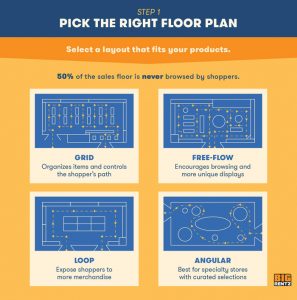— By Jim Arabia —
Grocery stores in particular generate big boosts in sales from refreshing and remodeling.
The fear of online shopping overtaking in-store purchases certainly hasn’t hit the grocery market yet, with a Gallup poll showing 84% of U.S. shoppers never buy their food from the internet.

Jim Arabia, BigRentz
With that in mind, many retailers — not just grocery stores — are ensuring their physical store is keeping pace with customer needs, through remodeling and introducing more technology for a better shopping experience.
Indeed, artificial intelligence (AI) is playing its part — with robots to help customers find products and keep an eye on empty shelves, while smart shopping carts can recognize and weigh items and even predict another ingredient (think spaghetti and meatballs).
When giving your store an overhaul, it’s obviously important to focus on the basics, too, such as layout, floor plan and visual merchandising.
These components can have psychological effects on your shoppers. The most important thing is to tell a story in your store and utilize all building features and optimize the senses to influence shopping behavior. Here are some top tips to build a profitable remodel.
 Pick the Right Floor Plan
Pick the Right Floor Plan
50% of a sales floor is never browsed by shoppers, so it’s important to select a layout that fits your products. For example:
- Grid: organizes items and controls the shopper’s path.
- Free flow: encourages browsing and more unique displays.
- Loop: exposes shoppers to most merchandise.
- Angular: best for specialty stores with curated sections.
Setting the Customer Journey
- High-value products up front: this is important because customers determine the store’s value in the first 5 to 15 feet.
- Lead to the right: 90% of customers turn right unconsciously when entering a store.
- Point to powerwall display with new products: customers make a judgment about your brand within 90 seconds.
- Essentials at the back: staple products will direct your customer to the back of the store.
- At least 4-foot-wide aisles: shoppers will avoid entering an aisle where they will brush someone’s backside.
- Small products near checkout: 27% of shoppers make additional purchases at the checkout.
Rebuilding Displays
- Put displays near aisles to slow down shoppers: shoppers skip 20% of store merchandise due to long aisles.
- High profit products at eye level: items at eye level receive 35% more attention than products elsewhere.
- U-shaped or vignettes: science shows that humans are naturally drawn to rounded shapes.
- Product QR cards: 84% of shoppers use their smartphone to help shop in store.
 Build an Experience
Build an Experience
Use solid backgrounds to highlight your products: believe it or not, shoppers base 60% of their decision to purchase a product on color alone!
Blue = trust
Green = relaxing
Red = energetic
Yellow = youthful
Black = powerful
Pink = romantic
Orange = aggressive
Purple = calming
Tailor your lights
A study shows lighting designed to create an experience lifted sales by 12%.
- Spotlights will focus more attention.
- Backlights will give products a glow.
- High activity lights are used to cover the entire store.
- A warm temperature creates an inviting space.
- Cool temperature evokes a larger space.
Engaging the Senses
- Playing fitting music: a survey showed shoppers were more likely to buy French wine when French music is playing.
- Incorporate scents: a study by Martin Lindstrom found that the smell of apple pie led to the purchase of more ovens.
- Provide samples and demos: 64% of consumers said they shop at a physical store for the ability to touch, feel and try out things.
- Curate products around a story: visuals increase a person’s message retention by 42%.
Staying Open During Remodeling
In addition to maintaining your revenue, keeping your doors open will allow your customers to witness the changes and be excited about the remodel. Follow these tips to ensure a smooth remodeling process while maintaining your business hours.
- Communicate with your customers and employees. Let them know you are planning a remodel and what they can expect. This will give everyone time to prepare.
- Break into stages. Stages prevent your entire store from going out of commission. Spend time on essential areas and push out the less crucial ones.
- Time and plan the construction. Try to schedule the remodel during slower times of the year. Work with your contractor to specify and set entrance areas for personnel.
- Contain the construction. Make sure you set clear barriers and zones to prevent safety hazards and distractions for your customers and your employees.
- Remodel after hours. This will incur more costs but will provide the least interference.
- Offer customers courtesy discounts. Give your customers a reason to visit and help maintain them with small discounts or gifts.
As the future of brick-and-mortar stores continues to change, it’s important to keep your strategy top of mind. To ensure a smooth remodel, be sure you set your priorities, create a timeline and hire a commercial contractor with the right resources and equipment.
A good example of store remodeling in 2018 was Target — the retail chain began remodeling 1,000 of its stores nationwide, including brighter lighting and modern displays and signage. According to a study conducted by FieldAgent, 56% of shoppers said they would shop at Target following the changes.
Creating a store experience that offers the advantages of brick-and-mortar retail while setting apart your brand will keep your retail store competitive in the age of online.
— Jim Arabia is vice president of marketing for construction equipment supplier BigRentz, which supplies contractors and retailers nationwide who build and redevelop retail stores. Big Rentz’s operations team has noticed a growth in companies redesigning stores.
